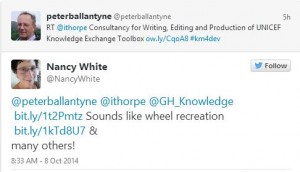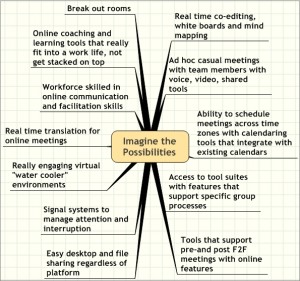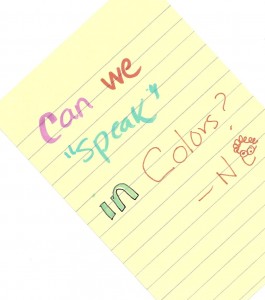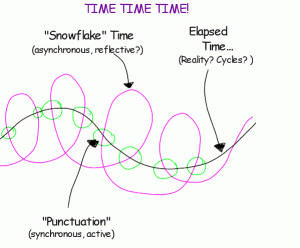Warning: The following was written in haste, has repetition and can very much stand a good edit. But if I don’t hit post, this won’t go out. Life is busy.
Earlier today my friend and respected KM/KS practitioner Ian Thorpe Tweeted a link to a consultancy announcement.

I blithely responded:
Now, I was pretty tough on Ian and did not offer any context. Later this morning he posted a really thoughtful blog post on the thinking behind his organization’s desire to have their own internal Knowledge Exchange Toolbox. I started to post a comment, but the comment grew so large I decided a post here was called for.
I’m going to quote a sizable chunk of his post and then my response. But if this interests you, please go read the whole thing.
But, I think there are actually a few good reasons to reinvent or at least adapt.
People working in an organization tend to have more trust, and are thus more likely to use something that has been specifically created for them and has some form of official endorsement. This sounds like “not invented here syndrome” – but it’s not quite that.
The advantages of developing your own toolkit (or platform, strategy, bibliography, taxonomy etc.) include:
- It can be written in the kind of language (and jargon and buzzwords) people in the organization understand
- It can include tools selected to meet the specific needs of the organization, and the tools selected (even when sourced from elsewhere) can be adapted and tailored to the organizational context.
- The tools can be tested on real organizational problems and the feedback obtained can be used to improve them and help communicate them better.
- The tools can go through a quality review and sign off process that the organization understands and respects.
- The fact that the toolbox is developed together with internal as well as external expertise means that staff know who they can follow-up with for advice and support on when and how to use them.
Overall these points mean that there is a sense of organizational ownership of the toolbox meaning not only is it officially sanctioned, but also officially supported and adapted to what the organization needs.
Thanks for adding really useful context, Ian. I find your reasoning totally logical. I have also heard it many times at other organizations.
First, can we connect usage to the factors you noted above in the context of ownership? Has anyone objectively looked at how usage of such a tool matters if it is internal or external?
I strongly suspect usage is driven by other, less visible, more informal things like seeing other peers use the tools, having colleagues they value endorse or role model, etc. I don’t have data. But in considering this, I wonder about our assumptions about
- the use of these toolkits in general, and
- the importance of the points you make toward use (and improvements going forward).
Or are we just masking or missing the deeper, underlying issues? I really don’t know and I’d really LIKE to know.
I confess, I get totally frustrated when my own clients hire me to do things that are already done. The KS Toolkit came out of that frustration after three separate clients asked for the SAME thing and the differentiating factor was not whether the tool was on a private intranet or public, but branding. Yes, branding. Does that change the value of the toolkit? Should it? Now, that said, over time the existing Toolkit product needs improvement. And your focus on adaptation is to me SUPER IMPORTANT. The issue of how to create and improve cooperatively sourced products alone deserves another blog post. (Note to self). But lets go back to rationale for internal vs. cooperative, shared resources.
I think a lot of the points you make are right on, but I also worry about some of the underlying causes that make these ideas of “needing internal validation,” “our language” and stuff so important in a field like international development and cooperation. From where I sit, I thought our field has shared goals. So why do we have these counterproductive insider, invented here, not invented here, we are different from everyone else, etc attitudes? What do they represent? Control? Power? Fear? Territoriality? Reliance on the status quo?
Do we really understand if and why we need our unique products? Or is our vision too limited to see both the value and possibility for, and the mechanisms to cooperatively create, use, and improve resources?
Let me get more specific and look at each of Ian’s reasons for a customized product.
- It can be written in the kind of language (and jargon and buzzwords) people in the organization understand. Having a sense of identity and ownership is important. But reinforcing organizational buzzwords and jargon does not help wider cooperation in the development field, no? Why might we want to reinforce this behavior? Think of the “beneficiaries” as well. Doesn’t our insider language and jargon distance us from them?
- It can include tools selected to meet the specific needs of the organization, and the tools selected (even when sourced from elsewhere) can be adapted and tailored to the organizational context. This is a compelling argument for internal platforms. Curation, adaptation and tailoring are really useful “value added” to a toolkit. But why not do that adaptation in a public, cooperative platform where others can learn from what you do, particularly those closest to your organizational domains. Why not do it WITH those others? Hm, as I write this, I wonder about shifting from “organizational” context to “practice” or “domain” context. So if tool X is more useful in working with Y population, lets make sure all of us working with Y population have access to that tool adaptation and can contribute towards its ongoing improvement?
- The tools can be tested on real organizational problems and the feedback obtained can be used to improve them and help communicate them better. I can’t figure out the value of this being internal to an organization. Again, it relates to the practice, no? The global public good here is pretty darn high…
- The tools can go through a quality review and sign off process that the organization understands and respects. Why can’t this happen in a cooperative platform? Heck, it might even contribute to better interorganization practices as a whole? And who is the arbiter of quality at the tool level when we rarely seem to care or pay attention at the application level where the IMPACT happens, right?
- The fact that the toolbox is developed together with internal as well as external expertise means that staff know who they can follow-up with for advice and support on when and how to use them. Again, I can imagine this same value on a public/cooperative platform.
Adaptation is an important thing we ignore very often in KM. There is too much sense that replication and scaling are the solution. So I deeply respect this aspect of adaptation that I sense in Ian’s response.
My “yes, and” perspective is that what you learn/do through adaptation is of value beyond your org. And insights come from beyond your org. And your org exists for public good, right? Why not build more nuanced structures that facilitate open, public, crowdsourced resources, ones that add that layers of adaptation – for example there are other orgs sharing UNICEF’s targets and goals who might also benefit from this need to improve tools.
I fully know that what I’m suggesting is not easy. We have learned through the KSToolkit.org that people DO have different needs, need the material organized or expressed differently. But those reasons don’t appear to be organizational. They appear to be driven by the users context and practice. And that these contexts and practices vary WITHIN organizations, and are often shared ACROSS organizations. And cooperatively creating and supporting a shared resource doesn’t fit into most organizational process or budgeting parameters, so when we see things like the KSToolkit.org we are seeing the work of committed individuals who make things happen, often in spite of their organizations. (And deep bow to all of you, including Ian who has been a toolkit supporter.)
I think there is a much larger, more valuable proposition of opening up some of this work across organizations and getting off the focus on our organizations. Lets focus on our goals and the ultimate reason we are doing this. So every human being has the right to and access to food, clean water, housing, education and human dignity.
So what are the barriers? What is it we are really avoiding by sharing this “knowledge infrastructure?” Is it convenience? When we work for global public good, what is the cost of this “convenience?” What is keeping us from shifting towards more cooperative and networked structures which can tap a potentially broader and more diverse set of expertise, share the burden of refinement, adaptation, improvement and just simply reduce this recreation? We all need and benefit from the process of adapting and improving tools. Many of the tools in a Knowledge Exchange toolkit will have relevance to wider audiences. At the same time, so much of what is in these toolkits is not rocket science. What IS rocket sciences is the organizational shifts and changes that actually enable people to USE this stuff. Toolkits are just a resource. And this opens another Pandora’s box for another blog post!
I’ll say it. Lets start breaking down more walls instead of using what is convenient and conventional to maintain the status quo. And a little starting point like KM and KS toolkits seems like an ideal laboratory to find new, cooperative, networked ways to maximize value and minimize waste. Let’s recreate and improve together. Otherwise we are supporting wheel reinvention.
And Ian, thanks for lighting me up to write about this today. You have helped me clarify my thinking. The next two things we need to consider is what it takes to cooperatively create global public goods (and a lot of good people have been doing some great work in other domains from which we can learn), and how to move the tools from toolboxes into practice!
via Why we sometimes need to reinvent the wheel | KM on a dollar a day.






























Hi Nancy,
Great comments and insights. An area that strikes me about online communities versus face to face meetings is the power of questions, provocative statements or interesting artefacts. It’s interesting to see how a question can transform a group – a powerful question can take on a life of it’s own re-energizing a dormant group. I’ve watched this happen over the years with the online facilitators community. The more controversial, the better – conflict online which seems to be fast and furious provides incredible learning not too mention, engagement.
Awhile ago, I read about a posting on ebay about antique hair pins. Fascinating to see the number of hits this post received and each time someone added to the knowledge on antique hair pins – (an internal wiki for ebay, I suppose) Who woud have thought a posting on hair pins would have generated so much content and engaged a community of followers. I’m not certain how long the community stayed together but I’m also not certain this matters. Online communities was and wane, dropping in and out of conversations as they please – this peripatetic lifestyle drives dynamic dialogue and ensures engagement – (even if only, fleetingly
[…] White of Full Circle Associates has made a very useful blog post asking what we mean by engagement online. Nancy is the preeminent online facilitator, and her answers to her own question are a great outline […]
[…] in communities, vocational education and training at 4:51 am by ednavet Nancy White thinks that engagement in any community is on a spectrum from active participation in a group to […]
Nancy,
Your mention of tone is very important. In English classes we were hit with tone and many students did not get the message which is so important in this time of online and text communication. Since voice inflection is missing in online communication participants and facilitators must be very careful with their word choices. Since we are often in such a hurry to finish a task we often are careless with word choice. In face to face communication so many more cues are available.
Nancy,
In online learning, one of our hurdles is when we ask our participants to do group activities. Many balk and find reasons why they cannot get together with others for group activities online.
Seeing your concept of time online (thank you for the visual–it’s awesome), I wonder if you have some insight on quelling these “yeah, but” type responses to group activities in online learning. I think the problem is entangled in the time issue.
Cinde
Marcia, yes yes yes — I think in our hurry we cheat our own communications.
Cynthia, it is funny you mention this because this ended up be a topic of conversation in an online gathering this past week with a bunch of educators in Florida.
A couple of the things I do with “yea, but” are:
1. Start with small, well defined collaborative tasks that build up trust, reciprocity and visibility of the value and interdependence of group work. I find people will be less likely to “let down” someone they have gotten to know a bit. The socialization seems to matter (from my experience working with adults.)
2. Debrief the initial collaboration to identify what made it work/not work. Sometimes I ask tough questions like “what would happen if you did not participate in this activity?” or “what are the consequences of your non-participation.” (social pressure)
3. If the group is not being generative in the assignment, “flip it.” So ask for work that is counter productive to the desired outcome (which people often find amusing and think I’m joking). So if your goal was to design a lesson for 10th graders on Beethoven, ask them to design the perfect lesson where students would learn nothing. Absolutely nothing. What could faillsafe this goal? They generate the list. Then ask them how many things are in place for failure in the work they are doing now. Prioritise the top one or two things they can do something about and then they redesign their learning context to support, rather than defeat, participation (ask me questions if I did not explain that very well. ) I learned this from Keith McCandless – he calls it TRIZ.
[…] via Full Circle Associates » What do we mean by engagement online?. […]
[…] What do we mean by engagement online?- Full Circle, September 8, 2009 […]
[…] What do we mean by engagement online? | Full Circle Candace Whitehead, the Facilitator Support Specialist for the Florida Online Reading Professional Development project funded by the Florida DOE and housed at the University of Central Florida http://forpd.ucf.edu contacted me last month inviting me to participate in a web meeting with the cohort of online facilitators working in learning and particularly around literacy issues. The chance to have a conversation with practitioners is always an automatic YES for me. When we talked, Candace suggested the topic of “engagement.” This blog post is a little bit of “thinking out loud” prior to our conversation later this month. (tags: tm_picks IDEA engagement bestpractices online_learning online_facilitation) […]
[…] What do we mean by engagement online? | Full Circle […]
Nancy,
Enjoyed this post – and your experiences are quite helpful as this is the area that fascinates me most in virtual collaboration.
I have formed a collaborative learning group on Linked to explore this topic in a socially open forum. I hope you and your readers will consider joining and engaging with this group to share your experiences, knowledge and questions.
Here is a link to the group http://www.linkedin.com/groupInvitation?groupID=2350136&sharedKey=19C1004846E9
OR once signed into LI, search on groups for Radical Inclusion – Open Virtual Collaboration
All the best.
Nancy:
Wow, there’s some great stuff here. I’m a meeting and event professional that focuses on the education design of face-to-face and virtual experiences. I’ve been thinking for some time about how to make our face-to-face events more social, allowing more horizontal, peer-to-peer collaborative learning. So much of conference time is spent sitting passively in chairs listening to an expert “sage on the stage.” Participants want more dialogue and less monologue.
I’ve also been playing with hybrid meetings, integrating the virtual with the face-to-face to extend the learning experience and allow people to engage with each other and the content. So you’re post resonates with me a lot.
Dr. Davis Fougler calls “snowflake time” “supersynchrony.” He says supersynchronly allows online attendees to control the level of synchrony with parallel interactions, which magnifies learning opportunities and retention. No longer do learners need to use “turn-taking in discussions,” where words follow words, paragraphs follow paragraphs, people taking turns to speak. Instead of following a single one-way linear straight line fixed presentation, online learners have the ability to break and restore communication linearity. They can scroll back from the moment the statements was posted, while interacting presently in the here-and-now, resulting in several conversations happening all at the same time allowing for additional data flow and increased productivity. He and other researchers call this online productivity “bending time” or “hyper time through polylogues.”
Those of us that say that is information overload, too much information coming at us at once, have not yet mastered what many Gen X & Ys have: information synthesis. Information Synthesizers don’t feel overwhelmed by information – they either use it or they don’t, but they don’t whine that there’s too much. Oh, wait, that’s a different post than this one about engaging with content and people.
Thanks for being a springboard for more thinking and allowing me to run with some thoughts here.